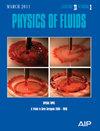Extensive computational fluid dynamics analysis of microchannel flow topology and friction factor in arrays of conical pin-fins
IF 4.1
2区 工程技术
Q1 MECHANICS
引用次数: 0
Abstract
The design of integrated circuits presents an increasing challenge for engineers, who seek to identify effective methods for cooling the miniature electronic components that are becoming increasingly complex. One potential solution is the use of micro pin-fin heat sinks, which have the potential to be an effective thermal management technique. This study compares the potential thermo-hydraulic efficiency of micro heat exchangers with conical pin-fins, arranged in two alternative patterns. The flow topology was investigated using the critical points theory and Ω-criteria to gain a deeper understanding of vortical structures and flow separation. 75 variations of pin-fin arrays were simulated and analyzed. It is noteworthy that no pattern similar to bidirectional pin-fins has been studied previously. The input datasets for the simulations included pitch/height ratios ranging from 0.823 to 1.235, cone angles from 0° to 13.48°, and flow Reynolds numbers of 40–117. The numerical results show that Ω and kinetic energies can predict the onset of instabilities. The degree of conicity and the pattern affect the friction factor, typically reducing it. The conical shape and arrangement of pin-fins can also aid in stabilizing the flow. Furthermore, the dependence of the friction factor on pitch/height and Reynolds was quantified with the calculated mean relative error of 1.7%. Moreover, turbulence parameters and friction factors were used to evaluate the thermohydraulic properties, deliberately excluding heat transfer simulations. This approach allows a much wider range of geometric modifications to be investigated for the preliminary optimization of the thermal and hydraulic performance of microchannels.对锥形针状鳍片阵列中的微通道流动拓扑和摩擦因数进行广泛的计算流体动力学分析
集成电路的设计给工程师带来了越来越大的挑战,他们需要找到有效的方法来冷却日益复杂的微型电子元件。一种潜在的解决方案是使用微型针脚鳍片散热器,它有可能成为一种有效的热管理技术。本研究比较了微型热交换器的潜在热液压效率,该热交换器采用锥形针形鳍片,以两种不同的模式排列。使用临界点理论和 Ω 标准对流动拓扑结构进行了研究,以加深对涡流结构和流动分离的理解。模拟和分析了 75 种不同的鳍针阵列。值得注意的是,以前没有研究过类似双向针形鳍的模式。模拟的输入数据集包括间距/高度比从 0.823 到 1.235,锥角从 0° 到 13.48°,流动雷诺数为 40-117。数值结果表明,Ω 和动能可以预测不稳定性的发生。锥度和模式会影响摩擦因数,通常会降低摩擦因数。锥形形状和针状鳍的排列也有助于稳定气流。此外,摩擦因数与螺距/高度和雷诺的关系也得到了量化,计算得出的平均相对误差为 1.7%。此外,还利用湍流参数和摩擦因数评估了热流特性,特意排除了传热模拟。通过这种方法,可以对更广泛的几何形状进行研究,从而初步优化微通道的热力和水力性能。
本文章由计算机程序翻译,如有差异,请以英文原文为准。
求助全文
约1分钟内获得全文
求助全文
来源期刊

Physics of Fluids
物理-力学
CiteScore
6.50
自引率
41.30%
发文量
2063
审稿时长
2.6 months
期刊介绍:
Physics of Fluids (PoF) is a preeminent journal devoted to publishing original theoretical, computational, and experimental contributions to the understanding of the dynamics of gases, liquids, and complex or multiphase fluids. Topics published in PoF are diverse and reflect the most important subjects in fluid dynamics, including, but not limited to:
-Acoustics
-Aerospace and aeronautical flow
-Astrophysical flow
-Biofluid mechanics
-Cavitation and cavitating flows
-Combustion flows
-Complex fluids
-Compressible flow
-Computational fluid dynamics
-Contact lines
-Continuum mechanics
-Convection
-Cryogenic flow
-Droplets
-Electrical and magnetic effects in fluid flow
-Foam, bubble, and film mechanics
-Flow control
-Flow instability and transition
-Flow orientation and anisotropy
-Flows with other transport phenomena
-Flows with complex boundary conditions
-Flow visualization
-Fluid mechanics
-Fluid physical properties
-Fluid–structure interactions
-Free surface flows
-Geophysical flow
-Interfacial flow
-Knudsen flow
-Laminar flow
-Liquid crystals
-Mathematics of fluids
-Micro- and nanofluid mechanics
-Mixing
-Molecular theory
-Nanofluidics
-Particulate, multiphase, and granular flow
-Processing flows
-Relativistic fluid mechanics
-Rotating flows
-Shock wave phenomena
-Soft matter
-Stratified flows
-Supercritical fluids
-Superfluidity
-Thermodynamics of flow systems
-Transonic flow
-Turbulent flow
-Viscous and non-Newtonian flow
-Viscoelasticity
-Vortex dynamics
-Waves
 求助内容:
求助内容: 应助结果提醒方式:
应助结果提醒方式:


